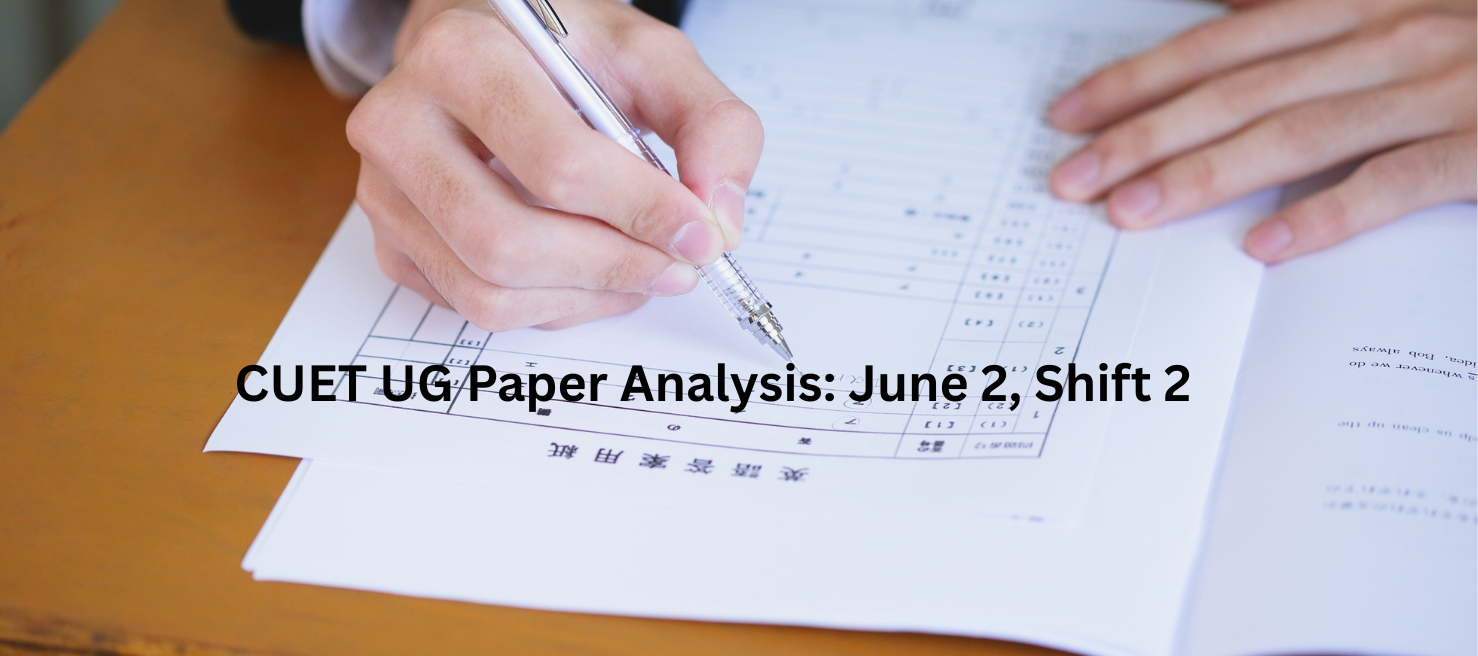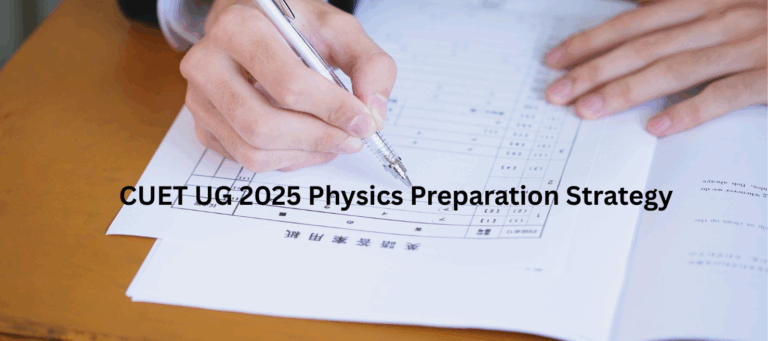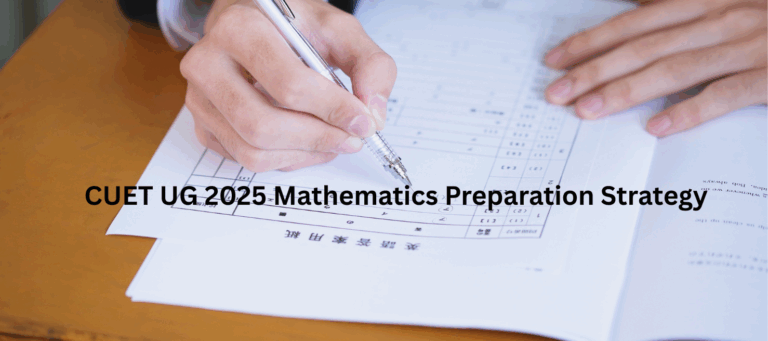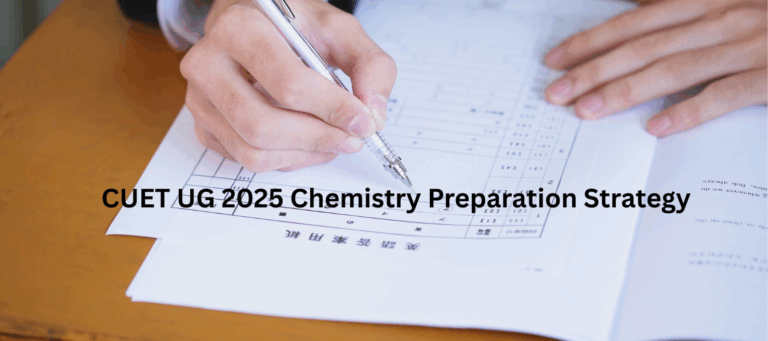
The CUET UG 2025 exam, conducted on June 2nd, Shift 2, tested the knowledge and aptitude of thousands of aspirants across various subjects, including General Aptitude Test (GAT), English, Physics, Chemistry, and Political Science. This shift presented a well-rounded challenge with a balanced mix of conceptual and application-based questions, designed to assess the depth of candidates’ understanding. Each section brought its own set of complexities, from the reasoning and analytical skills evaluated in GAT to the language proficiency required in English, and the scientific concepts tested in Physics and Chemistry. Political Science, on the other hand, focuses on contemporary and theoretical knowledge of political systems and ideologies.
In this comprehensive exam analysis of CollegeDost, we will explore the difficulty level, question types, important topics covered, and overall trends observed, offering aspirants a clear perspective on what to expect and how to strategize for future shifts.
- May 13th CUET UG Paper Analysis Shift 1
- May 13th CUET UG Paper Analysis Shift 2
- May 14th CUET UG Paper Analysis Shift 1
- May 14th CUET UG Paper Analysis Shift 2
- May 15th CUET UG Paper Analysis Shift 1
- May 15th CUET UG Paper Analysis Shift 2
- May 16th CUET UG Paper Analysis Shift 1
- May 16th CUET UG Paper Analysis Shift 2
- May 19th CUET UG Paper Analysis Shift 1
- May 19th CUET UG Paper Analysis Shift 2
- May 20th CUET UG Paper Analysis Shift 1
- May 20th CUET UG Paper Analysis Shift 2
- May 21st CUET UG Paper Analysis Shift 1
- May 21st CUET UG Paper Analysis Shift 2
- May 22nd CUET UG Paper Analysis Shift 1
- May 22nd CUET UG Paper Analysis Shift 2
- May 23rd CUET UG Paper Analysis Shift 1
- May 23rd CUET UG Paper Analysis Shift 2
- May 24th CUET UG Paper Analysis Shift 1
- May 24th CUET UG Paper Analysis Shift 2
- May 26th CUET UG Paper Analysis Shift 1
- May 26th CUET UG Paper Analysis Shift 2
- May 27th CUET UG Paper Analysis Shift 1
- May 27th CUET UG Paper Analysis Shift 2
- May 28th CUET UG Paper Analysis Shift 1
- May 28th CUET UG Paper Analysis Shift 2
- May 29th CUET UG Paper Analysis Shift 1
- May 29th CUET UG Paper Analysis Shift 2
- May 30th CUET UG Paper Analysis Shift 1
- May 31st CUET UG Paper Analysis Shift 1
- June 2nd CUET UG Paper Analysis Shift 1
- June 3rd CUET UG Paper Analysis Shift 1
- June 3rd CUET UG Paper Analysis Shift 2
CUET UG 2025 Exam Overview
Below is the exam overview of CUET UG 2025.
| Exam Particulars | Exam Details |
| Total Subjects Offered | 37 (13 Languages + 23 Domain Subjects + 1 General Aptitude Test) |
| Medium | 13 Indian languages (Assamese, Bengali, English, Gujarati, Hindi, Kannada, Malayalam, Marathi, Punjabi, Odia, Tamil, Telugu, and Urdu) |
| Subjects to Choose | Up to 5 subjects |
| Total Marks of CUET Exam | 250 |
| Questions per Subject | 50 Compulsory Questions |
| Marking Scheme | +5 for correct answer, -1 for incorrect answer, and no marks for unattempted questions |
| Exam Mode | CBT Mode |
| Duration | 60 minutes per subject |
Where To Check CUET UG 2025 Paper Analysis
Hey! If you want to know the detailed CUET UG 2025 analysis from 13th May till now, click on the link below.
👉 Check CUET UG 2025 Exam Analysis on CollegeDost
CollegeDost provides comprehensive insights into the exam pattern, question difficulty, and section-wise breakdowns, all based on real-time feedback from students who have recently appeared for the exam. With expert evaluations and practical tips, CollegeDost serves as a resource to help candidates understand the exam better and strategize their preparation effectively.
CUET UG 2025 Exam: Shift Timings Today
Check the CUET UG 2025 exam shift timings in the table below.
| CUET UG 2025 Slot Time for 2nd June | Reporting Time | Gate Closing Time | Shift Timing |
| CUET UG 2025 Shift 1 | 7 AM | 8.30 AM | 9 AM to 12 PM |
| CUET UG 2025 Shift 2 | 1 PM | 2.30 PM | 3 PM to 6 PM |
CUET Exam Pattern 2025
The CUET UG 2025 exam is structured to assess various skills across multiple subjects. Below is a detailed breakdown of the exam pattern:
| Sections | Subjects / Tests | No. of Questions | Question Type |
| Section IA | 13 different languages (any one can be chosen) | 50 | Reading Comprehension based on different types of passages – Factual, Literary, and Narrative; includes Literary Aptitude and Vocabulary |
| Section II | 23 domain-specific subjects (choose as per eligibility) | 50 | MCQs based on the NCERT Class XII syllabus |
| Section III | General Test (for programs where it’s used for admission) | 50 | General Knowledge, Current Affairs, General Mental Ability, Numerical Ability, Quantitative Reasoning (up to Grade 8 level), Logical and Analytical Reasoning |
CUET UG 2025 Exam Analysis: Based on the Number of Attempts
Candidates can check the number of good attempts that they can expect in the exam from the following table.
| CUET UG Subjects | Difficulty Level | Good Attempts |
| General Aptitude Test | Easy to Moderate | 35-45 |
| English | Easy | 45+ |
| Physics | Moderate | 30-35 |
| Chemistry | Easy to Moderate | 35-45 |
| Political Science | Easy | 30-35 |
CUET UG 2025 Exam Analysis: June 02, 2025, Shift 2
The CUET exam date 2025 of June 2nd, shift 2, for the GAT, English, Physics, Chemistry, and Political Science paper. As per the students’ initial reaction, the exam for the Shift 2 is considered easy to moderate. Check out the subject-specific analysis and weightage of each chapter.
CUET UG 2025 GAT Paper Analysis
Students found the Maths section moderately challenging, with most questions focused on Profit & Loss, Mensuration, SI/CI, and Geometry, requiring clear conceptual understanding. Logical Reasoning was considered easy to moderate, with familiar topics like coding-decoding, blood relations, and visual reasoning, though the number of questions varied. However, the General Knowledge section was a balanced mix of static and current affairs, students found questions on Chandrayaan 3, EWS policy, and historical events moderately tricky but manageable.
| Section | Difficulty | Topics Covered | No. of Questions (Approx.) |
| Mathematics | Moderate | Profit & Loss (case-based), SI/CI, Ratio, Mensuration, Geometry (cube, cuboid, triangle), Algebra, Number System, Time & Work, Equation Solving, Height-Distance | 15–16 |
| Logical Reasoning | Easy to Moderate | Blood Relation, Odd One Out, Coding-Decoding, Visual Reasoning (paper folding, figure series), Circular Seating, Calendar, Direction, Ranking | 8–10 |
| General Knowledge | Moderate | Chandrayaan 3, AP Capital, NA Mountains, Gautam Buddha’s Sermon, EWS Policy, Mukti Bahini, Book Arrangement, Static & Current Affairs | 15–20 |
General Awareness-Chapterwise Weightage
The table below highlights the importance and distribution of different subjects within the General Awareness subject.
| Category | Expected Questions |
| Geography | 7 |
| Science | 4 |
| Personalities | 4 |
| Polity | 3 |
| Defence | 2 |
| Awards | 2 |
| Sports | 1 |
| Currency | 1 |
| Miscellaneous | 1 |
Logical reasoning-Chapterwise Weightage
The table below emphasizes the chapter-wise weightage for the Logical Reasoning section.
| Topic | Expected Questions |
| Visual Reasoning | 4 |
| Series | 2 |
| Coding-Decoding | 2 |
| Arrangement | 2 |
| Clocks | 2 |
| Analogy | 1 |
| Family Tree | 1 |
| Calendar | 1 |
| Data Sufficiency | 1 |
| Directions | 1 |
| Statement-Conclusion | 1 |
Numerical Ability-Chapterwise Weightage
The table below emphasizes the chapter-wise weightage for the Numerical Ability section.
| Topic | Expected Questions |
| Time and Work | 2 |
| Ratio | 2 |
| Simplification | 1 |
| Fractions | 1 |
| HCF-LCM | 1 |
| Problems on Age | 1 |
| Percentage | 1 |
| Profit, Loss & Discount | 1 |
| Simple Interest | 1 |
| Area | 1 |
| Volume | 1 |
| Speed, Time, Distance | 1 |
| Mean & Mode | 1 |
| Triangle | 1 |
| Trigonometry | 1 |
CUET UG 2025 English Paper Analysis
Students found the Reading Comprehension passages easy but slightly lengthy, which made scrolling a bit time-consuming. According to the students, sentence Rearrangement was very easy and helped score quickly using option elimination. However, the vocabulary section, including synonyms, antonyms, idioms, and phrasal verbs, was simple and familiar, with many repeated words like “Bellicose” and phrases like “spill the beans.” Grammar was minimal, with a few questions on prepositions, homophones, and figures of speech, while no One Word Substitution was asked in this shift.
| Section | Details |
| Reading Comprehension | 3 passages (solar energy, music, childhood memories), easy but lengthy; ~12–15 questions |
| Sentence Rearrangement | 7–10 questions, very easy, solved quickly via elimination; not to be skipped |
| Synonyms & Antonyms | Approx 8 to 10 questions; words included Bellicose, Aggrandize, Lavish, Munificent, Indolent, Timorous, Sagacious |
| Idioms & Phrasal Verbs | Easy level; examples: “spill the beans”, take down, put down, give away, iron out |
| Grammar | Few questions, including prepositions, homophones (“fairy”), and figures of speech (Pun, Alliteration, Oxymoron) |
CUET English Chapterwise Weightage
The table below highlights the importance and distribution of different subjects within the English subject.
| Topics | Number of Questions |
| Comprehension | 15 |
| Parts of speech | 3–4 |
| Para jumbles | 3–4 |
| Synonyms and antonyms | 2–3 |
| Active/passive voice | 3–4 |
| Fill in the blanks | 3–4 |
| Incorrect/correct statement | 3–4 |
| Phrases and meaning | 5–6 |
CUET UG 2025 Physics Paper Analysis
Students found Magnetism and Current Electricity to be the most frequently asked and scoring topics, with several direct and conceptual questions. Ray Optics had good weightage, especially on lenses, microscopes, and refraction. However, Modern Physics has around five questions, mostly from PN Junction Diodes. Capacitors and electromagnetic waves were also commonly tested. Moreover, there were formula-based and straightforward questions from AC circuits, EMI, and Coulomb’s Law. Overall, students felt the paper leaned towards familiar concepts with a mix of theory and application-based problems.
| Topics | Details |
| Modern Physics | PN Junction Diode (theory + diagram), current direction in the diode |
| Magnetism | Moving Charge & Magnetism, Magnetism & Matter – most frequent topic |
| Current Electricity | Multiple conceptual and circuit-based questions |
| Electric Charge & Field | Standard conceptual questions |
| Ray Optics | Microscope, Telescope, Refraction (rarer to denser medium), Lens Power & Combination |
| Electromagnetic Waves | Arrange by wavelength, Match waves with applications |
| Electromagnetic Induction | Self-Induction formula-based question (nΦ = LI) |
| Capacitors | 3–4 circuit-based questions |
| Resistors | Parallel EMF & internal resistance calculation (E_eq, R_eq) |
| Coulomb’s Law | Force comparison using F = kqâ‚qâ‚‚/r² |
| AC Circuits | Transformers, Resonance |
| Rainbow Formation | Conceptual question in the morning shift |
CUET Physics-Chapterwise Weightage
The table below highlights the importance and distribution of different subjects within the Physics subject.
| Chapter | Number of Questions |
| Physical World & Measurement | 1–2 |
| Kinematics | 1–2 |
| Laws of Motion | 2–3 |
| Work, Energy, and Power | 2–3 |
| Motion of a System of Particles & a Rigid Body | 2–3 |
| Gravitation | 1–2 |
| Thermodynamics | 2–3 |
| Kinetic Theory | 1 |
| Oscillations and Waves | 2–3 |
| Mechanical Properties of Solids & Fluids | 1–2 |
| Electrostatics | 2–3 |
| Current Electricity | 2–3 |
| Magnetic Effects of Current & Magnetism | 2–3 |
| Electromagnetic Induction | 2 |
| Alternating Current | 1–2 |
| Electromagnetic Waves | 1 |
| Ray Optics and Optical Instruments | 2–3 |
| Wave Optics | 1 |
| Dual Nature of Matter and Radiation | 1–2 |
| Atoms and Nuclei | 2–3 |
| Semiconductor Electronics | 2–3 |
| Communication Systems | 1 |
CUET UG 2025 Chemistry Paper Analysis
Students found the Chemistry paper easy to moderate, with many saying it leaned more toward the easy side. Physical Chemistry had straightforward questions on boiling point, molarity, and conductance, including a couple of simple numericals problems. However, Inorganic Chemistry focused on oxidation numbers, f-block configurations, and magnetic moments, which students found familiar. Many students reported that Organic Chemistry covered reaction mechanisms, amino acids, and a few theory-based questions, all of which were manageable. Overall, students felt the paper was balanced, with most questions being direct and scoring.
| Area | Topics Covered | Question Types |
| Physical Chemistry | Boiling Point, Molarity, Molality, Conductance, Cell Constant, Specific Conductance, SRP | Conceptual & Numerical |
| Inorganic Chemistry | Oxidation Number, Electronic Configuration (F-block), Magnetic Moment (D-block), Coordination Number | Statement-based, Match the Following |
| Organic Chemistry | Naming Reactions, Aldehyde Production, Organic Reactions, Amino Acids (types), RNA (non-existent form) | Match the Following, Theory |
| Reaction Kinetics | Order of Reaction | Theory |
| Coordination Compounds | Ligands, Optical Isomers | Conceptual |
| Miscellaneous | Pictorial Representation of Reactions (identify the impossible one) | Visual-based |
CUET Chemistry-Chapterwise Weightage
The table below highlights the importance and distribution of different subjects within the Chemistry subject.
| Topics | Number of Questions |
| Solid State | 4 |
| Electrochemistry & Solutions | 5 (Case study – Slightly difficult) |
| Chemical Kinetics | 2–3 |
| P Block Elements | 2–3 |
| D and F Block Elements | 5 (Case study – Easy) |
| Coordination Compounds | 5–6 (Moderately difficult) |
| Alcohols, Phenols, and Ethers | 4–5 |
| Aldehydes, Ketones, and Carboxylic Acids | 3–4 |
| Organic Compounds Containing Nitrogen | 4 |
| Polymers | 1–2 |
| Chemistry in Everyday Life | 1–2 |
CUET UG 2025 Political Science Paper Analysis
Students found the Political Science paper mostly straightforward, with questions closely aligned to NCERT, mock tests, and previous year papers. Most questions came from the second book, Politics in Independent India, covering familiar topics like the 1952 elections, the Mandal Commission, and the Shah Bano case. Many students reported that the first book had fewer questions but tested key Cold War topics like the Warsaw Pact, Berlin Wall, and Boris Yeltsin. Students who revised the NCERT thoroughly and understood major democratic and international events, and found the paper easy and scoring.
| Section/Book | Topics Covered |
| Politics in Independent India | 1952 Lok Sabha Elections, Basic Structure (Kesavananda Bharati case), Mandal Commission, Shah Bano Case, Rajiv Gandhi’s China visit |
| Contemporary World Politics | Cold War (Warsaw Pact, Berlin Wall, Boris Yeltsin), International Events |
| Key Events & Years | – Fall of the Berlin Wall: 1989 – Warsaw Pact: 1955 – Boris Yeltsin Presidency: 1991 – Mandal Report: 1980 – Implementation: 1990 – Shah Bano Case: 1985 – Rajiv Gandhi’s China Visit: 1988 |
| Paper Insight | All questions aligned with NCERT, mocks, PYQs; beneficial for students well-versed with the Cold War and Indian democracy |
CUET Political Science Chapterwise Weightage
The table below highlights the importance and distribution of different subjects within the Political Science subject.
| Chapters | Number of Questions |
| Recent Developments in Indian Politics | 8–9 |
| Challenges to the Congress System | 5 |
| Cold War Era | 3–4 |
| The End of Bipolarity | 2–3 |
| US Hegemony in World Politics | 2–3 |
| Alternative Centers of Power | 2–3 |
| Contemporary South Asia | 3–4 |
| International Organizations | 2–3 |
| Security in the Contemporary World | 2–3 |
| Globalization & Environment and Natural Resources | 6–7 |
Student Reviews For CUET UG 2025 June 2nd Shift 2 Exam
Most students from different states found CUET UG 2025 Shift 2, which was held on June 2nd, to be easy to moderate. Here is a summary of what students perceived about the exam.
General Aptitude Test (GAT)
Student Feedback: Students found GAT overall moderate, with Logical Reasoning slightly easier than expected. Maths questions focused more on Profit & Loss, Mensuration, and SI/CI, requiring clear conceptual understanding. GK had a balanced mix of static and current affairs, with many questions from NCERT, PYQs, and mocks.
English
Student Feedback: Reading comprehension was easy but slightly lengthy, requiring time to scroll and process. Sentence rearrangement and vocabulary (synonyms/antonyms) were seen as easy scoring areas. Many questions were direct and repeated from earlier shifts, making it a comfortable section overall.
Physics
Student Feedback: Students rated it as moderate, with questions mostly from Magnetism, Current Electricity, and Ray Optics. Formula-based and theory questions were common. Those who revised Moving Charge & Magnetism and Ray Optics scored well.
Chemistry
Student Feedback: Chemistry was easy to moderate; students appreciated the directness of most questions. Covered familiar NCERT topics like Boiling Point, Electrochemistry, Coordination Compounds, and Organic Reactions. Numerical problems were simple and few.
Political Science
Student Feedback: Students who revised the NCERT and mock tests found this section very scoring. Most questions came from “Politics in Independent India”, especially the 1952 elections, the Mandal Commission, Shah Bano case. Cold War topics (e.g., Warsaw Pact, Berlin Wall) were tested; students felt well-prepared due to familiar themes.
CUET UG 2025 Exam Day Guidelines
Given below are a few CUET UG 2025 exam day guidelines that students need to follow.
- Carry Only Required Items: Only take your printed admit card (with passport-size photograph), your valid photo ID (Aadhaar or PAN card), a transparent ballpoint pen, and a transparent water bottle. Candidates can check all the CUET exam details on the admit card and are advised to adhere to the instructions.
- Be On Time: Report to the exam center well in advance relative to your reporting time (7:00 AM for Shift 1 and 1:00 PM for Shift 2). If you are late, you will not be allowed to enter.
- Prohibited Items: Do not bring mobile phones, smart watches, electronic devices, bags, books, or food if not medically required (with documentation).
- Maintain Discipline: Be seated in your assigned seat, only do rough work on the sheets provided, and do not perform any unfair practice or make any noise in the exam hall.
- Time Management: It is a critical challenge across subjects, especially with lengthy sections like RC or Quant. It’s advised to tackle easy questions first.
- The Normalisation Factor: This factor will account for variations in difficulty across shifts. The focus should be on attempting as many questions with 100% accuracy.
CUET Dress Code For Females
| Category | Allowed | Not Allowed |
| Clothing | Half-sleeved, simple kurtis/tops | Full-sleeved, heavily embroidered, or layered clothing |
| Bottom Wear | Simple leggings, trousers, salwar | Skirts, jeans with extra pockets |
| Footwear | Slippers, flat sandals | Heels, closed-toe shoes, boots |
| Accessories | None | Jewelry (earrings, rings, bangles, bracelets, belts) |
| Electronic Items | None | Smartwatches, Bluetooth devices, and wired accessories |
CUET Dress Code 2025 for Males
| Category | Allowed | Not Allowed |
| Clothing | Half-sleeved, plain shirts or t-shirts | Full-sleeved shirts, layered clothing, and embroidery |
| Bottom Wear | Light trousers, simple jeans | Cargo pants, jeans with too many pockets |
| Footwear | Slippers, sandals | Shoes, sneakers, boots |
| Accessories | None | Watches, belts, caps, sunglasses, metallic items |
| Electronic Items | None | Smartwatches, Bluetooth devices, and wired accessories |
Things Allowed Inside the Examination Hall
- Transparent Water Bottle
- Admit Card (printed copy)
- Face Mask & Gloves (if applicable)
- Personal Hand Sanitiser (50 ml)
- Rough Sheets (provided by the exam centre)
- Passport-size Photograph (same as uploaded in the application)
- Simple Black/Blue Ballpoint Pen (if specified)
- Valid Photo ID Proof (Aadhar, PAN, Passport, etc.)
Things Not Allowed Inside the Examination Hall
- Books, Notes, or Any Study Material
- Mobile Phones & Smartwatches
- Wallets, Handbags, Sunglasses
- Bags, Pouches, or Any Items with Metal Components
- Electronic Gadgets (earphones, calculators, etc.)
- Jewellery, Caps, or Hats
- Food or Drinks (except water)
- Any Written or Printed Papers
What’s New In CUET UG 2025?
Check out some new changes UGC introduced and will be implemented from CUET UG 2025 onwards.
- Students can now take CUET UG exams in any subject, regardless of their Class 12th subjects.
- CUET UG will be conducted solely in CBT mode.
- CUET subjects have been reduced to 37 from 63. Teaching Aptitude, Entrepreneurship, and Legal Studies subjects has been removed.
- The duration of the test is 60 minutes for all the subjects.
- The GAT scores will decide the admission for the removed CUET subjects.
- There will be no optional questions.
Frequently Asked Questions
1. Which topics were emphasised in the English section of CUET UG 2025?
The English paper featured three reading comprehension passages on topics like solar energy, music, and personal memories. There were 7 to 8 sentence rearrangement questions, and vocabulary questions included synonyms and antonyms of words like “Bellicose,” “Aggrandize,” and “Lavish.” Phrasal verbs such as “Take down,” “Put out,” and “Give away” were also tested.
2. What were the key topics in the Chemistry section of the shift 2 of 2nd June in CUET UG 2025?
In the Chemistry paper, the questions were covered from the physical chemistry topics like boiling point and molarity, electrochemistry concepts such as cell constant and specific conductance. There were questions from organic chemistry topics, including amino acids and reaction mechanisms.
3. Which topics were emphasized in the Physics section during CUET UG 2025 on 2nd June?
In the Physics paper, the key topics included magnetism, current electricity, electric charge and field, ray optics, electromagnetic waves, electromagnetic induction, capacitors, resistors, Coulomb’s law, and AC circuits.
4. How was the difficulty level of the exam in this shift of CUET UG 2025 on 2nd June?
The exam presented a balanced mix of moderate to challenging questions, with conceptual and application-based problems across all subjects.
5. What types of questions were included in the Logical Reasoning part of CUET UG 2025?
The Logical Reasoning part of the GAT has questions involving blood relations, coding-decoding, odd one out, visual reasoning (paper folding, embedded figures), and circular seating arrangements.






